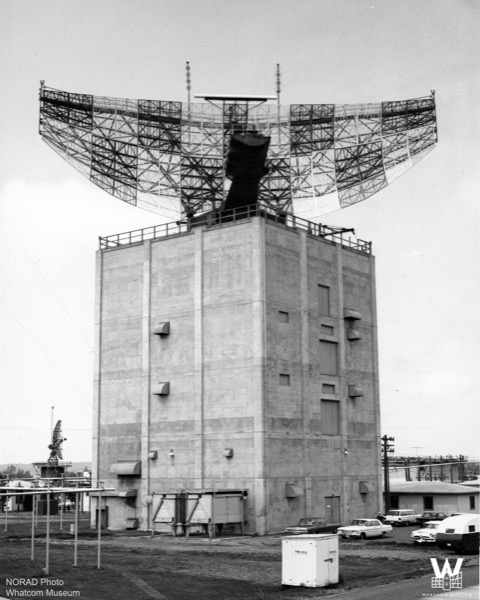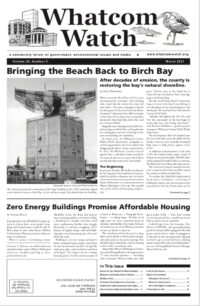by Hailee Wickersham

Photo of the Blaine Air Force Station in 1966. The back of the photo is printed with the caption: “SCANNING THE SKIES – This huge radar antenna provides part of the information that the men of the Back Up Interceptor Control Center require to make their air defense decisions. It is manned by technicians of the United State Air Force’s Air Defense Command.”
Photographer is unknown. Courtesy of the Whatcom Museum.
The Blaine Air Force Station was one of 28 stations that was built as part of the Air Defense Command. In the early 1950s, the United States Air Force saw a need for increased aerial protection in certain sectors of North America.
Birch Bay was chosen for its proximity to the Northern border as well as its viewpoint advantage for being close to sea-level and in-sight of the horizon. In July of 1950, the U.S. Army Corps of Engineers proceeded with construction from gravel excavated out of the bay to erect the station.
In 1952, the 757th Air Control and Warning Squadron began operating AN/FPS-10 radars from the station. Throughout the operation time of the station, the radars used were upgraded multiple times to improve accuracy and efficiency. In 1960, the station incorporated SAGE (semi-automatic ground environment), it worked in-line to coordinate with NORAD (North American Aerospace Defense). NORAD is a combined organization between the United States and Canada that provides aerospace warning and protection for North America.
At the time, the station could house roughly over 200 Air Force members and at least 20 officers in the Bachelor Office Quarters (where commissioned officers were typically housed).
In the 1960s, the station was expanded to include a gym and recreational area as part of “operation facelift.” It has been said by previous station-members to have been the Commanding Officer’s idea of creating a more enjoyable living environment for the members living onsite.
There was a limited but full-service dining hall onsite and shopping was restricted to exchanges that took place on station. In addition, there was a woodworking hobby shop that soldiers would often use to build boats to put on the bay or cabinetry for the barracks.
A bowling alley was even built into the basement of the personnel and family services building.
Post Cold War, the NORAD center shifted gears to begin intercepting possible drug operations in the 1970s. For example, if a small aircraft flying above was perceived to be involved in drug operations in the United States — the station could intercept it.
At the same time that other radar stations in North America were closing and being stationed elsewhere, the Blaine Air Force Station was eventually decommissioned in Jan. 1979. Today, the area is named Bay Horizon Park and Whatcom County owns the now 69-acre property. It’s used primarily for Lions Club and their facility, Camp Horizon, which is devoted to individuals with disabilities.
_______________________________
Hailee Wickersham is a student-journalist at Western Washington University. You can find more of her work at haileeistyping.wordpress.com.





























